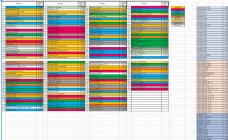Lone Hunter
Silver $$ Contributor
You should also throw H4895 in the mix too. They (69 gr SMK) shot really well out of my .223. It was a Remington 700 LTR.Ok thanks I have some 69 grain SMKs
You should also throw H4895 in the mix too. They (69 gr SMK) shot really well out of my .223. It was a Remington 700 LTR.Ok thanks I have some 69 grain SMKs
Is 4895 the same as Tac ?You should also throw H4895 in the mix too. They (69 gr SMK) shot really well out of my .223. It was a Remington 700 LTR.
It’s pretty close to it in the burn rate chart but not the same, it’s faster.Is 4895 the same as Tac ?
 748 is another powder in .223 that I have had good luck with but used it mainly in lighter bullets. Here is a burn rate chart someone on this site posted about a month ago that shows a lot of different manufacturers and burn rates.
748 is another powder in .223 that I have had good luck with but used it mainly in lighter bullets. Here is a burn rate chart someone on this site posted about a month ago that shows a lot of different manufacturers and burn rates.Ya I have some X terminator I think will be good for lighter bullets also in the 223It’s pretty close to it in the burn rate chart but not the same, it’s faster. View attachment 1440335748 is another powder in .223 that I have had good luck with but used it mainly in lighter bullets. Here is a burn rate chart someone on this site posted about a month ago that shows a lot of different manufacturers and burn rates.
I put some nice groups together over the weekend with 77 SMK and N140. 23.0, 23.5, and 24.0 all yielded 0.5 MOA groups with 24.0 putting out a .25 MOA, all in varying winds, 100 yards.That VV N140 is good powder but can be hard to find .
I haven't tried the Match yet, but as you stated 2520 and CFE 223 (My best groups) are near perfect with 75's and an 8 twist.Many records were broken with 2520, meters like water, that being said the new Staball match im testing is looking awesome……as is CFE223.
Ok thanks guysI haven't tried the Match yet, but as you stated 2520 and CFE 223 (My best groups) are near perfect with 75's and an 8 twist.
Yes - I agree. There is always a tradeoff going light/heavy. One either has to dial up/down for trajectory or be better able to adjust for wind when going light. As another mentioned, BC has a lot to do with it - but not everything, as you state. Given the nice dial scopes we have and range finders - dialing up/down is the easy route for most folks. Me - I'd be inclined to think a much more accurate load than 1/2 MOA can be found with the lighter bullets in a .223 - at least that has proven the case in my rifles and those I have set up for others. I certainly think a 52 grain bullet, for example, has the energy to whack a coyote at 400 to 500 yards as another asked. But it depends a lot on how quickly it opens AND penetrates. I'd take a 50-grain Varmint Grenade over almost all else if shooting at coyotes at 400 yards. They are wicked accurate once properly tuned and open up way out there. They have poor BC relative to the 69's and up - but personally - I'd take accuracy and a good bullet and learn to live with the wind.I am not home today as it's my son's 38th birthday but when I get home Monday I'll sit up.
The heavier projectiles always made range estimates a PITA they have a better SD/BC but the trajectory arc sucked.
That was my choice, the hyper velocity 40 grain VMAX shooting 1 1/16" at 300 yards was plenty good and the expansion even out to 400 is devastating.Yes - I agree. There is always a tradeoff going light/heavy. One either has to dial up/down for trajectory or be better able to adjust for wind when going light. As another mentioned, BC has a lot to do with it - but not everything, as you state. Given the nice dial scopes we have and range finders - dialing up/down is the easy route for most folks. Me - I'd be inclined to think a much more accurate load than 1/2 MOA can be found with the lighter bullets in a .223 - at least that has proven the case in my rifles and those I have set up for others. I certainly think a 52 grain bullet, for example, has the energy to whack a coyote at 400 to 500 yards as another asked. But it depends a lot on how quickly it opens AND penetrates. I'd take a 50-grain Varmint Grenade over almost all else if shooting at coyotes at 400 yards. They are wicked accurate once properly tuned and open up way out there. They have poor BC relative to the 69's and up - but personally - I'd take accuracy and a good bullet and learn to live with the wind.

